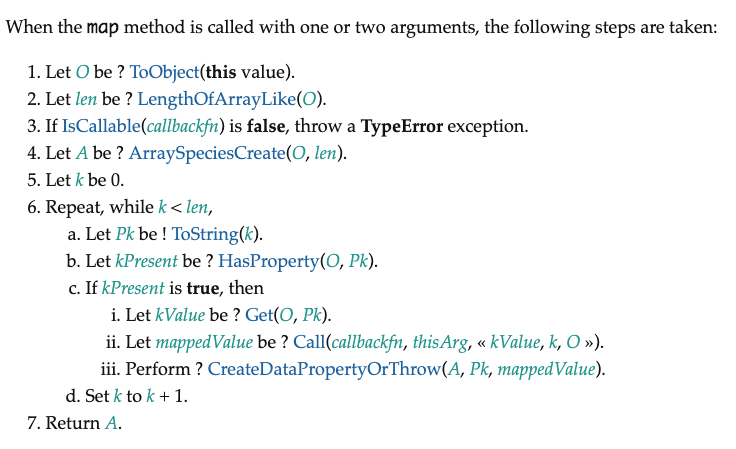# Array.prototype.map()
依照 ecma262,实现的map的规范如下:

下面根据规范一步步来模拟实现map函数:
Array.prototype.map = function (callback, thisArg) {
// 处理数组类型异常
if (this === null || this === undefined) {
throw new TypeError("Cannot read property 'filter' of null or undefined")
}
// 处理回调类型异常
if (Object.prototype.toString.call(callback) !== '[object Function]') {
throw new TypeError(callback + ' is not a function')
}
let O = Object(this), // 转换为对象
len = O.length >>> 0, // 为Number的正整数
A = new Array(len); // 定义原长度的空值数组
for (let k = 0; k < len; k++) {
// 使用 in 在原型链查找
// 如果用 hasOwnProperty 是有问题的,它只能找私有属性
if (k in O) {
let kValue = O[k]
// 依次传入this, 当前项,当前索引,整个数组
let mappedValue = callback.call(thisArg, kValue, k, O)
A[k] = mappedValue
}
}
return A;
}
总体实现起来并没那么难,需要注意的就是使用 in 来进行原型链查找。同时,如果没有找到就不处理,能有效处理稀疏数组的情况。
这里解释一下, length >>> 0, 字面意思是指"右移 0 位",但实际上是把前面的空位用0填充,这里的作用是保证len为数字且为整数。
举几个例子:
null >>> 0 //0
undefined >>> 0 //0
void(0) >>> 0 //0
function a (){}; a >>> 0 //0
[] >>> 0 //0
var a = {}; a >>> 0 //0
123123 >>> 0 //123123
45.2 >>> 0 //45
0 >>> 0 //0
-0 >>> 0 //0
-1 >>> 0 //4294967295
-1212 >>> 0 //4294966084
最后给大家奉上V8源码,参照源码检查一下,其实还是实现得很完整了。
function ArrayMap(f, receiver) {
CHECK_OBJECT_COERCIBLE(this, "Array.prototype.map");
// Pull out the length so that modifications to the length in the
// loop will not affect the looping and side effects are visible.
var array = TO_OBJECT(this);
var length = TO_LENGTH(array.length);
if (!IS_CALLABLE(f)) throw %make_type_error(kCalledNonCallable, f);
var result = ArraySpeciesCreate(array, length);
for (var i = 0; i < length; i++) {
if (i in array) {
var element = array[i];
%CreateDataProperty(result, i, %_Call(f, receiver, element, i, array));
}
}
return result;
}
参考: